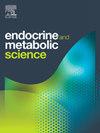CRF1 receptor antagonists in congenital adrenal hyperplasia: A systematic review and meta-analysis of phase 2 open-label and phase 3 clinical trials
Q3 Medicine
引用次数: 0
Abstract
Introduction
Classical Congenital Adrenal Hyperplasia (CAH) due to 21 hydroxylase deficiency is a rare autosomal recessive disorder. Recent clinical trials indicate that type 1 Corticotropin-releasing hormone receptor OR CRFR1 receptor OR CRF1 antagonists could provide a new treatment option for CAH. Hence, we conducted a systematic review and meta-analysis to evaluate the efficacy and safety of these drugs in patients with CAH.
Methods
Medline, Embase, and Cochrane Library were searched for eligible studies. Analysis of Phase 2b and Phase 3 clinical trials was carried out. Mean percent changes and event numbers were pooled to perform a single-arm meta-analysis. Binary data was pooled from Phase 3 clinical trials. Statistical analysis was performed using RStudio version 4.1.2 (R Foundation for Statistical Computing), under a random-effects model. Heterogeneity was assessed using I2 statistics.
Results
From Phase 2 clinical trials, pooled efficacy data from studies with CRF1 antagonists resulted in a mean decrease from baseline levels in adrenocorticotropic hormone (ACTH) -57.86 %; 95 % CI -71.15 to −44.58 %; I2 = 0 %), 17-OHP (17-hydroxyprogesterone) (Mean − 40.01 %;95 % CI -66.31 to −13.71 %; I2 = 66 %) and androstenedione (−39.24 %; 95 % CI -62.77 to −15.70 %; I2 = 78 %). Overall, 71 % (95 % CI 53.91 % to 85.39 %) of the included patients experienced adverse events of any grade, with no significant difference between drug-type subgroups (P = 0.83). In Phase 3 trials, compared to placebo, CRF1 receptor antagonists resulted in a significant reduction of 17-OHP (MD: −6049.40 ng/dL; 95 % CI: −6665.23 to −5433.58 ng/dL; p < 0.01; I2 = 0 %), androstenedione levels (MD: −313.58 ng/dL; 95 % CI: −400.14 to −227.02 ng/dL; p < 0.01; I2 = 0 %) and need for glucocorticoid dose reduction (MD: −20.37 %; 95 % CI: −26.73 % to −14.00 %; p < 0.01; I2 = 47 %) No statistically significant difference was found between the two groups with respect to treatment emergent adverse effects 1.02 (95 % CI: 0.91 to 1.15; p = 0.72; I2 = 0 %) or treatment discontinuation 3.28 (95 % CI: 0.41 to 26.51; p = 0.27; I2 = 0 %).
Conclusion
CRF1 antagonists, especially Crinecerfont, are promising in the treatment of CAH. Phase 2b and Phase 3 clinical trials of CRF1 antagonists involving Crinecerfont demonstrated consistent results supporting its efficacy and safety. These studies showed significant reductions in ACTH, 17-OHP and androstenedione levels, as well as a decreased need for glucocorticoid doses, with no notable difference in adverse effects compared to placebo.
CRF1受体拮抗剂治疗先天性肾上腺增生:2期开放标签和3期临床试验的系统回顾和荟萃分析
摘要经典先天性肾上腺增生症(CAH)是一种罕见的常染色体隐性遗传病。最近的临床试验表明,1型促肾上腺皮质激素释放激素受体或CRFR1受体或CRF1拮抗剂可能为CAH提供新的治疗选择。因此,我们进行了系统回顾和荟萃分析,以评估这些药物对CAH患者的疗效和安全性。方法检索medline、Embase和Cochrane图书馆中符合条件的研究。对2b期和3期临床试验进行分析。平均百分比变化和事件数合并进行单臂荟萃分析。二进制数据来自3期临床试验。采用随机效应模型,采用RStudio 4.1.2版本(R Foundation for Statistical Computing)进行统计分析。采用I2统计量评估异质性。结果:从2期临床试验中,来自CRF1拮抗剂研究的综合疗效数据显示,促肾上腺皮质激素(ACTH)从基线水平平均下降57.86%;95% CI -71.15 ~ - 44.58%;I2 = 0%), 17-OHP (17-hydroxyprogesterone)(意味着−40.01%;95%可信区间-66.31−13.71%;I2 = 66%)和雄烯二酮(- 39.24%;95% CI -62.77 ~ - 15.70%;i2 = 78%)。总体而言,71% (95% CI 53.91% ~ 85.39%)的纳入患者经历了任何级别的不良事件,药物类型亚组之间无显著差异(P = 0.83)。在3期试验中,与安慰剂相比,CRF1受体拮抗剂导致17-OHP显著降低(MD: - 6049.40 ng/dL;95% CI:−6665.23 ~−5433.58 ng/dL;p & lt;0.01;I2 = 0%),雄烯二酮水平(MD:−313.58 ng/dL;95% CI:−400.14 ~−227.02 ng/dL;p & lt;0.01;I2 = 0%)和糖皮质激素减量需求(MD:−20.37%;95% CI:−26.73% ~−14.00%;p & lt;0.01;I2 = 47%)两组在治疗紧急不良反应1.02方面差异无统计学意义(95% CI: 0.91 ~ 1.15;p = 0.72;I2 = 0%)或停止治疗3.28 (95% CI: 0.41 ~ 26.51;p = 0.27;i2 = 0%)。结论crf1拮抗剂在治疗CAH方面具有较好的应用前景,尤其是criecerfont。涉及criecerfont的CRF1拮抗剂的2b期和3期临床试验显示一致的结果支持其有效性和安全性。这些研究表明,ACTH、17-OHP和雄烯二酮水平显著降低,糖皮质激素剂量需求减少,与安慰剂相比,不良反应无显著差异。
本文章由计算机程序翻译,如有差异,请以英文原文为准。
求助全文
约1分钟内获得全文
求助全文
来源期刊

Endocrine and Metabolic Science
Medicine-Endocrinology, Diabetes and Metabolism
CiteScore
2.80
自引率
0.00%
发文量
4
审稿时长
84 days
 求助内容:
求助内容: 应助结果提醒方式:
应助结果提醒方式:


